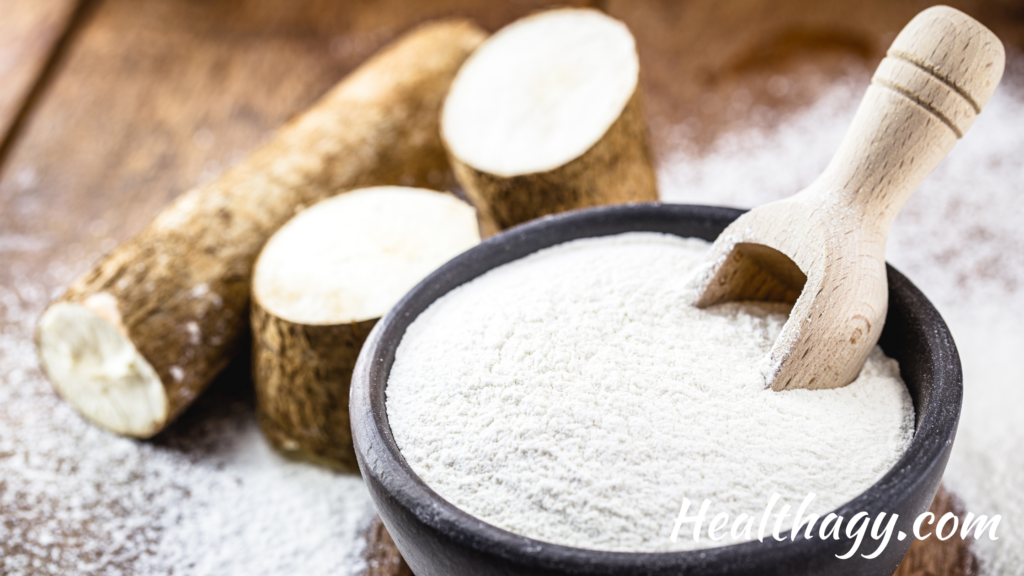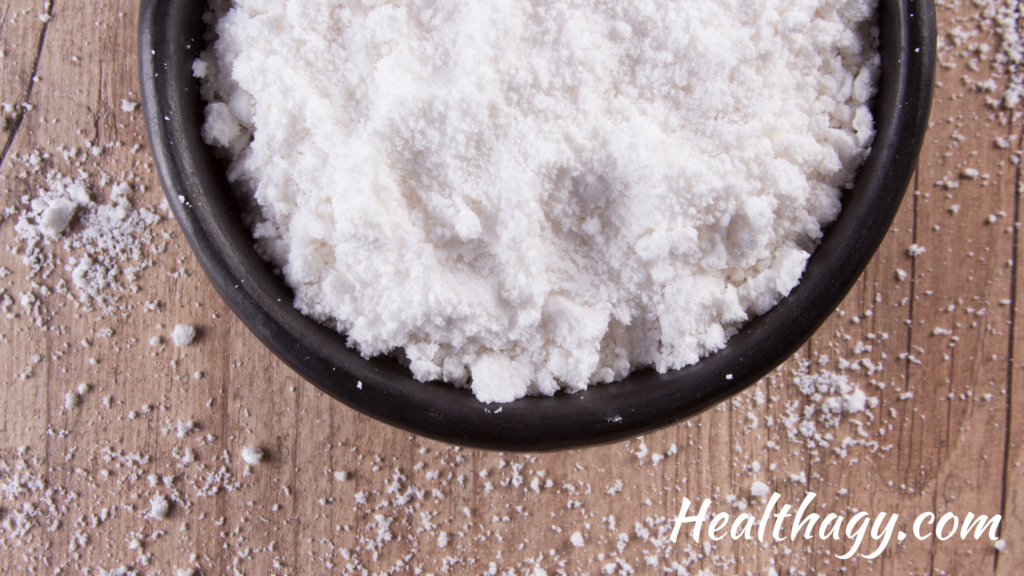
If you are on a gluten-free diet, doing any gluten-free baking, or have been reading your food labels, you’ve likely come across these two popular gluten-free flours, cassava and tapioca flour.
While they come from the same plant, and their names are often used interchangeably. They are, in fact, two different types of flour and will have different results when baking. There are times when one is a better choice than the other. But when? And is one a more nutritious option than the other?
We’ll dive into all this and more; keep reading below!
Key Differences Cassava Flour vs Tapioca Flour
The main difference between cassava flour vs tapioca flour is that cassava flour is made from the entire root of the cassava plant, while tapioca flour is made from what is left from dried starchy liquid extracted from the root.
Cassava flour contains fiber and a good amount of nutrients. Tapioca flour has no fiber and minimal nutritional value.
Tapioca flour does not contain fiber and has low nutritional value, while cassava flour provides several vitamins, minerals, and other nutritional values.

What is the Cassava Plant?
Manihot esculenta, more commonly known as the Cassava plant, is a plant grown in South America and a few other parts of the world, such as places in Asia and Africa. It has several regional names it goes by, such as manioc, tapioca, yuca, casabe, and mandioca. The cassava plant is best known for its root, which is a tuber. You may be familiar with other tubers: potatoes, yams, and sweet potatoes.
The cassava root shares similar qualities to the sweet potato, such as similar shapes and sizes, and you can also cook them similarly. But cassava root has a milder, more neutral taste and earthy flavor than the sweet potato.
What is Cassava Flour?
Cassava flour is the result of grinding the whole root of the cassava plant or the tuber into flour that can be used for cooking and baking. It has a texture similar to coconut flour, which is a bit gritty due to its fiber content. It is typically finely ground or grated and dried out, then processed into cassava flour.
Cassava flour is high in dietary fiber, carbohydrates, and potassium. It is naturally gluten-free, making it an excellent option for anyone on a plant-based, gluten-free, or paleo diet. It is a great gluten-free alternative for people with celiac disease or gluten sensitivity to wheat flour in bread and other baked goods.
It may be used as a thickening agent as it adds texture and body to sauces, gravies, and soups.

What is Tapioca Flour?
While tapioca flour and tapioca starch (they are the same thing) also comes from the cassava plant, it is not the same as cassava flour. Tapioca flour is made from the starchy liquid in the cassava root, which goes through a process of washing and pulping. The wet pulp is then squeezed, which leaves a starchy liquid. Once all the water evaporates, a fine white powder, tapioca flour, is left.
Tapioca flour, like cassava flour, has a mild and neutral flavor. It is most commonly used as a thickening agent and a binder to bind ingredients together in cooking and baking.
As a thickening agent, it works well, turning into a sticky, glue-like substance when mixed with water which helps it to bind agents together. It also acts similarly to gluten, which is why it is popular in gluten-free cooking.
Tapioca flour tends to be used in sweeter foods such as puddings, desserts, and ice cream, but it is used in a variety of different foods.
Nutrition and Health Benefits of Cassava Flour vs Tapioca Flour
Tapioca flour is high in carbohydrates with little nutritional value compared to cassava flour. It has a high glycemic index due to its high carbohydrate content and no fiber or protein to balance it out.
Cassava flour is also a good source of carbohydrates, potassium, vitamin C, vitamin A, and dietary fiber content.
A 1/4 cup or two ounces of cassava flour contains about 59 calories, 15.6 grams of carbohydrates, and 2.3 grams of dietary fiber. It has 9.3mg of Vitamin C, or 10% of the daily value and 455.8mg of potassium, or 10% of the daily value, and140IU or 5% DV of vitamin A, IU. Nutritional source.
The Best Gluten-Free Flour Substitutes
Cassava Flour
The best substitute for cassava flour for gluten-free cooking and baking is rice flour, and arrowroot flour will also work great. Chia seed flour, almond flour, coconut flour, or psyllium husk powder may also work as good alternative flours, depending on the recipe.
When it comes to the best options for changing regular recipes into gluten-free recipes, cassava flour can be used as a substitute for all-purpose flour. However, depending on the brand and quality of the cassava flour, it might not be a 1:1 substitute for a cup of all-purpose flour for a cup of cassava flour. Cassava flour is lighter than all-purpose flour, and you’ll likely need experimentation to perfect your recipe.
Cassava flour is absorbent and soaks up liquids quickly, much like coconut flour if you have worked with that. Cassava flour does not rise well, but if you add additional liquid, it helps boost the moisture content. Again, when it comes to substituting and gluten-free swapping, you always have to leave room for experimentation with the ratios.
Rice flour can also make a great addition combined with cassava flour as it helps to provide more structure and consistency.
Tapioca Flour
Tapioca flour can be considered a staple in gluten-free baking as it acts as a binder, similarly to gluten. A binder helps to bind or hold the ingredients together so they don’t become dry and crumbly. Tapioca flour works best when combined with another gluten-free flour. Together they can give baked goods a light and chewy texture while still providing some crispiness. You also don’t want to add too much tapioca flour to the mix, or the mixture will turn thick and gooey. Remember, it is meant to act like glue to keep the ingredients together, but too much will ruin the recipe.
Tapioca flour also makes a great substitute for cornstarch; when substituting, you only need to use half the cornstarch you would use in tapioca flour. If a recipe calls for two tablespoons of tapioca flour, you will substitute it with one tablespoon of cornstarch.
You can also use tapioca flour as a substitute for all-purpose flour in a 1:1 ratio, but only scarcely and in certain recipes, such as when all-purpose flour is used as a thickening agent in sauces, stews, and gravies. You would not use it as a 1:1 substitute in baked goods or as the main ingredient in a recipe; it would become thick and gooey.
Tapioca flour also makes a great substitute for potato starch, using a 1:1 ratio when used as a thickening agent for sauces, stews, and gravies. When it comes to baking, it is a heavier starch than tapioca, so you would use less potato starch than you would tapioca flour.
Key Takeaways
Cassava flour and tapioca flour come from the same plant, but they are two different flours used differently. They are both grain-free, gluten-free, and dairy-free, making them a good choice for cooking and baking for people on a gluten-free or paleo diet.
Cassava flour can be used as an alternative to all-purpose flour; it has nutritional value and contains fiber. Tapioca flour is used as a binder in recipes to hold ingredients together and has minimal nutritional value and no fiber.
Karla Kueber is a Certified Evidence Based EFT Practioner and Health Coach, with a double Masters Degree in Education. She works with people to overcome emotional eating, curb cravings, and overcome resistance to eating new healthy foods. You can learn more about coaching with her here.